Chrysanthemums, affectionately known as “mums,” are a cherished addition to gardens around the world. Their vibrant, colorful blooms and long-lasting beauty make them a favorite among gardeners. For seasoned horticulturists and novice gardeners alike, there’s something undeniably captivating about the elegant petals, calming hues, and delightful fragrance of mums. However, as with any beloved garden species, mums have their fair share of adversaries. Among the array of insects that find chrysanthemums irresistible, these notorious culprits stand out: chrysanthemum aphids, spider mites, leaf miners, whiteflies, and budworms.
It’s essential to stay vigilant and proactive in safeguarding your mums from these tiny but formidable foes as they can pose a serious threat to your garden. To effectively manage these pests and eradicate them, it’s crucial to get to know them better. Like they say: Keep your friends close; your enemies, closer. Read on to know more about each of these insects and how you can get rid of them once and for all.
Chrysanthemum aphids
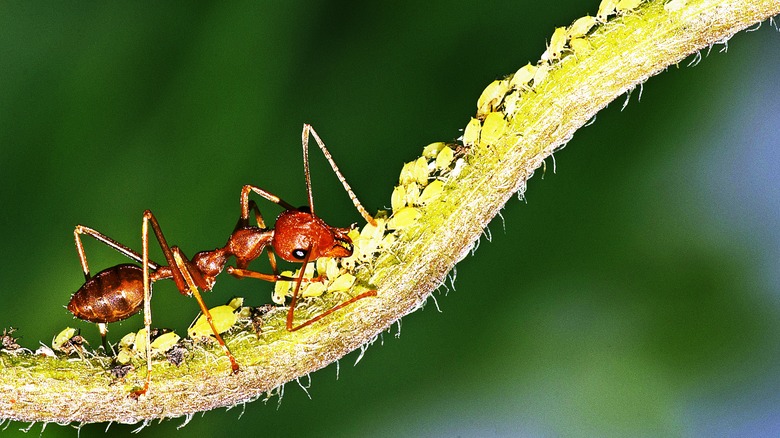
First on the list of mum destroyers are chrysanthemum aphids. These tiny, soft-bodied insects that can range in color from green to yellow or even pinkish are usually found congregating on the undersides of mum leaves and stems. They feed by piercing the plant tissues and extracting sap, causing leaves to curl, wilt, and become discolored. Aside from these obvious signs of aphid infestation, you might also notice a sticky residue excreted by the pests, known as honeydew, on the leaves or the ground beneath the plant. A high aphid population can lead to weakened chrysanthemum plants and unsightly foliage.
To manage aphids, start by reducing their numbers with a strong stream of water to dislodge them from the plant. Alternatively, apply neem oil or insecticidal soap to target and suffocate the aphids. You may also sprinkle food-grade diatomaceous earth around the base of your mums to deter crawling insects like ants, which spread and protect aphids.
Spider mites
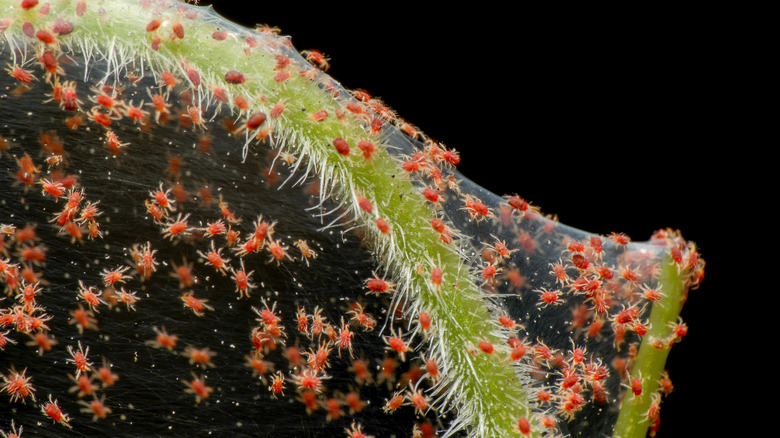
Next on the list are spider mites. These minuscule arachnids often go unnoticed until a serious infestation occurs. They thrive in dry, dusty conditions, and their activity results in a reduction in plant vitality. The first sign of a spider mite infestation usually comes in the form of leaves dotted with tiny yellow spots that can grow in size and number as the pests multiply unchecked. They suck the mum’s juices, leaving behind stippled, yellowing leaves, and fine webbing. If left unresolved, spider mite infestations can lead to stunted growth and even death for your chrysanthemums.
To get rid of spider mites, increase humidity around your plants by misting them regularly. Doing this will make the environment less favorable for the mites. You may also apply neem oil, horticultural oil, or insecticidal soap to control spider mites. Another direct method of killing them is using a 70% isopropyl alcohol spray.
Leaf miners
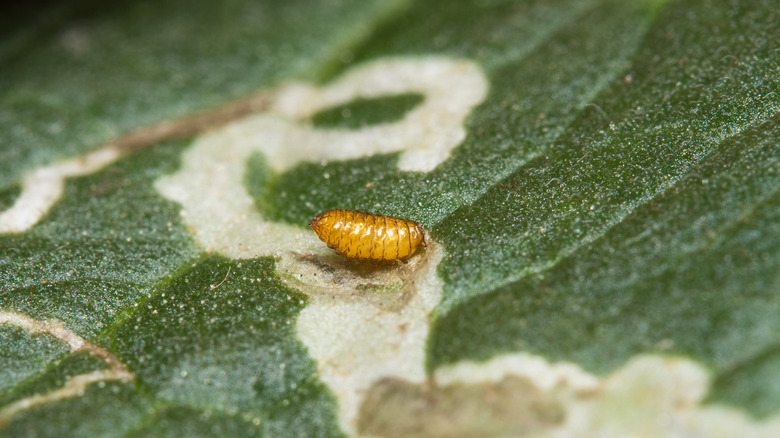
Muddy knees/Shutterstock
Chrysanthemum leaf miners are the larvae of a type of fly that lays its eggs on the underside of mum leaves. Once hatched, the larvae tunnel through the foliage, creating meandering, unsightly trails. This tunneling activity disrupts your mums’ ability to photosynthesize and weakens thier overall health. To check for leaf miners, look for winding trails on chrysanthemum leaves. These trails are created by the larvae as they feed inside the leaf tissue.
To make your chrysanthemum garden inhospitable to leaf miners, promptly remove and dispose of infested leaves to reduce the chances of larvae completing their lifecycle (you may also squash the larvae for good). You can also use neem oil, horticultural oil, or insecticidal soap to destroy the larvae within the leaf mines. Tilling the soil helps as well. It not only aerates the earth around your plants, but it can also damage or kill the pupa buried underground, effectively disrupting their development. Additionally, maintaining good garden hygiene by removing fallen leaves and debris can help reduce leaf miner numbers.
Whiteflies
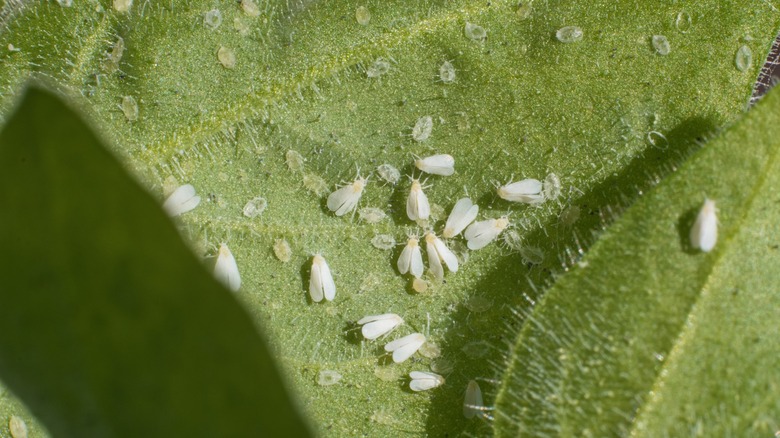
Tunatura/Shutterstock
Another common pest afflicting mums are whiteflies — those tiny, white, and moth-like insects with distinctive white wings. They gather in clusters on the undersides of mum leaves in large groups, feeding on plant sap by piercing the foliage with their needle-like mouthparts. Like aphids, they excrete a sticky substance known as honeydew as they feed. The honeydew they produce can encourage the growth of sooty mold on the leaves that may disrupt chlorophyll production. Infested foliage may turn yellow, and a severe infestation can weaken a plant drastically.
The control and deterrence of whiteflies typically involves a combination of strategies. Hose or wipe down the leaves with a clean, moist cloth if you notice any whiteflies gathering on them. Use yellow sticky traps placed strategically in your garden to attract and capture adult whiteflies. Additionally, apply neem oil or insecticidal soap to target the nymphs and stop their growth.
Budworms
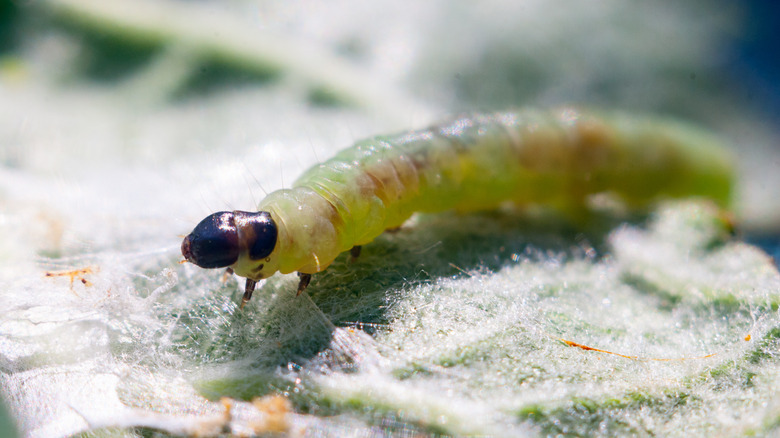
Mironmax Studio/Shutterstock
Feeding on the buds and flowers of chrysanthemums and other annual bedding plants, budworms are often small but ravenous caterpillars. They can vary in color from green to brown, making them blend in easily with the foliage. They chew through the petals and buds, leaving behind unsightly damage. Severe budworm infestations can lead to flower abortion, where buds drop off prematurely. Handpick budworms when you spot them and dispose of them promptly. To further control infestations, consider applying Bacillus thuringiensis (Bt), a biological insecticide specifically effective against caterpillars. The insecticide works by disrupting their digestive systems and is safe for humans, pets, and beneficial insects.
Now that we’ve identified these leading garden villains, you can apply effective pest control and elimination methods to keep your chrysanthemums thriving. Besides implementing pest-specific tips, regularly inspect your mums and remove infested leaves or stems to arrest infestation. Encourage beneficial insects like ladybugs, lacewings, and parasitic wasps (which prey on aphids, scale insects, whiteflies, and caterpillars) to make your garden their home by growing different plant species. Plant a variety of flowers, herbs, and shrubs to provide food and shelter for these garden-protecting insects. Consider including plants that are endemic to your area, as they often attract more native insects that are good for your garden. Early detection and consistent care are your best defenses against these chrysanthemum pests. By being a vigilant gardener and employing the recommended methods, you can ensure your mums remain a breathtaking focal point in your garden.



